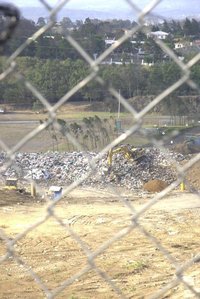Landfill
|
|
- For other uses see: Landfill (disambiguation).
Landfill_Hawaii.jpg
A landfill is an area designated to receive solid wastes, such as municipal solid waste (household trash), construction debris, and sludge from sewage treatment and other processes.
To reduce smells, vermin, and other health hazards, a layer of soil, usually an impermeable clay, is spread over each layer of garbage, usually at the end of each operating day. This is called the daily cover.
Modern, well-run landfills are also lined with plastic or bentonite clay to prevent toxic leachate from entering the groundwater. They also usually have gas wells to safely extract methane from the deepest parts. In many large landfills, this methane is piped to a generator to make electricity, but it is sometimes flared without energy production. A few landfills gas have tried to make conditions more favorable for methane production, primarily by increasing the moisture level of the garbage. However, the embodied energy of the waste can be recovered much more efficiently by directly combusting waste or using anaerobic digestion to produce methane, which is then burned to produce electricity. The modern plants are designed to burn cleanly and have pollution control measures as well. There will still be some pollution, but it is comparable to other energy sources. However, the grossly polluting garbage incinerators of the past have made the public wary of any waste combustion whatsoever.
Some local landfill authorities have found it difficult to locate nearby landfill areas. These authorites may charge a "tippage fee" in order to discourage waste or recover the cost of shipping waste to another area. Most areas in most countries do not have this problem. For many areas, a well-run landfill is a hygienic, inexpensive solution to garbage disposal. Poorly run landfills can pollute both air and groundwater.
Environmental activists dislike landfills not only because of the potential for pollution, but because they permanently remove various raw materials from economic use. All of the energy and natural resources (such as water) that were used to process the items "wasted" are also not conserved. This is said to contribute to damage of forests and agricultural areas, including in less-developed countries that derive a majority of their export revenues from raw materials. However, recycled materials compete in the marketplace with new materials. Most of the discarded materials are low in value, making it difficult to profit from their sale. This in turn reduces motivation to recycle.
Living close to a landfill is considered by many people to be very undesirable, therefore most landfills are built a reasonable distance away from settled areas, starting from 0.25 of a mile. Environmental pollution of land, air, and water created by the world's poorly-managed landfills is enormous.
In eras before the mid-20th century, landfills were the main method of waste management. In the late-20th century, alternative methods to waste disposal have been suggested, including recycling, converting to biodegradable products, incineration and cogeneration facilities, and sustainable development, all of which assist in reducing global pollution.
The "Fresno Municipal Sanitary Landfill", opened in Fresno, California in 1937, is considered to have been the first modern, sanitary landfill in the United States, innovating the techniques of trenching, compacting, and the daily covering of trash with dirt. It has been designated a National Historic Landmark, underlining the significance of waste disposal in urban society.
Some countries with a high population density, such as the UK, tax the use of landfills.
| Topics related to waste | edit (https://academickids.com:443/encyclopedia/index.php?title=Template:Waste&action=edit) | |
| Compost | Dustbins | E-waste | Garbage truck | Garbology | Greywater | Incineration | Landfill | Pollution Radioactive waste | Recycling | Sewage | Scrap | Sewage treatment | Toxic waste | Waste management | ||

